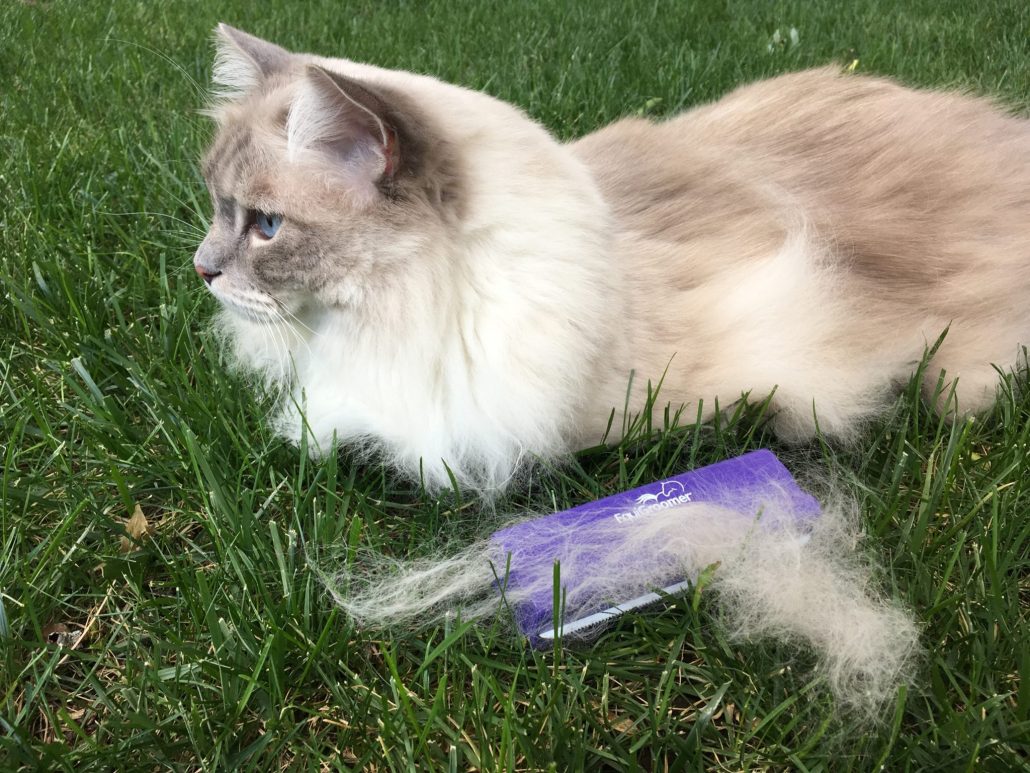Our pets rely upon their human guardians for their best life, health and comfort! Even though felines are great at self-grooming, your cat’s coat still needs your attention.
Learn why maintaining your pet’s coat is critical in our past blog post.

With as many as 130,000 hairs per square inch of a cat’s coat, it’s important to support their fur health every day! According to PetsWebMD, your cat’s hair can:
- Provide valuable sensory information.
- Offer protection from the heat/cold and wind/rain.
- Produce Vitamin D.
Next, let’s take a closer look at how to care for your cat’s coat with 4 tips for a shiny and lustrous coat.
How to Care for Your Cat’s Coat: 5 Tips
The Feline’s Coat: Diet

Like all animals, nutrition plays a HUGE role in healthy hair and skin! Without the proper balance of complex carbs, proteins, fats, minerals and vitamins, your cat could end up with dry and brittle hair, dry and itchy skin, dandruff and an overall dull, unhealthy coat. Extra weight can also lead to an unkempt, unhealthy coat when the cat can no longer reach and groom their fur, especially around the center of their back and base of the tail. (Age and arthritis can also play a role.)
When the feline coat is looking dull or the underlying skin is dry, flaky and irritated, it’s important to look at the cat’s daily diet. Always feed high-quality food from animal products and if necessary, supplement with fatty acids (including Omega-3) found in salmon or other fish oils. Always work with your cat’s vet to find the best diet for your feline.
Learn more about proper feline diets from the Cornell University College of Veterinary Medicine.
Regular Brush Your Cat’s Coat

Although cats are usually meticulous at self-grooming, regular brushing also helps support a soft and luxurious coat in cats of all ages. A grooming tool (like the EquiGroomer), can gently catch and remove the dead (and dull) hairs rejuvenating your cat’s overall coat. Brushing is also an excellent way to bond with your cat so always make time for it.
Learn more about proper feline diets from the Cornell University College of Veterinary Medicine.
Regular brushing can also help prevent:
- Hairballs.
- Matted fur.
- Excess loose hair in your home.
- Potential issues early like parasites.
Remember, brushing also provides the perfect opportunity to check your cat’s coat and skin for early detection, diagnosis and treatment of any medical issues.
Subscribe to our blog for future posts on how to care for
your dog and rabbit’s coat too. Subscribe at the bottom
of our homepage today!

The Feline’s Coat: Bathing
While regular bathing can help control dander, fleas or parasites, overbathing can lead to a dry and stressed coat for the kitty. If you’re unsure how often to bathe your cat, talk to a professional groomer or vet for expert advice.
If your cat’s coat tends to dry out after bathing, use an all-natural, moisturizing conditioning rinse (made for cats, never those made for humans or other pets).
Your Vet Can Help!
There can be several reasons behind a dull coat and dry skin.
- Parasites.
- Poor diet.
- Kidney, liver, adrenal or thyroid issues.
So always work with your vet to maintain your kitty’s best overall health, comfort and beautiful coat!

EquiGroomer: The Perfect Grooming Tool for Your Cat!
Ensure your feline’s best coat with regular brushing with the grooming
tool that is gentle and painless!
We guarantee your cat, dog, horse, other pets or livestock,
will LOVE the EquiGroomer Grooming Tools!
For individual or bulk orders, call 860-573-0604
or send us an email.


